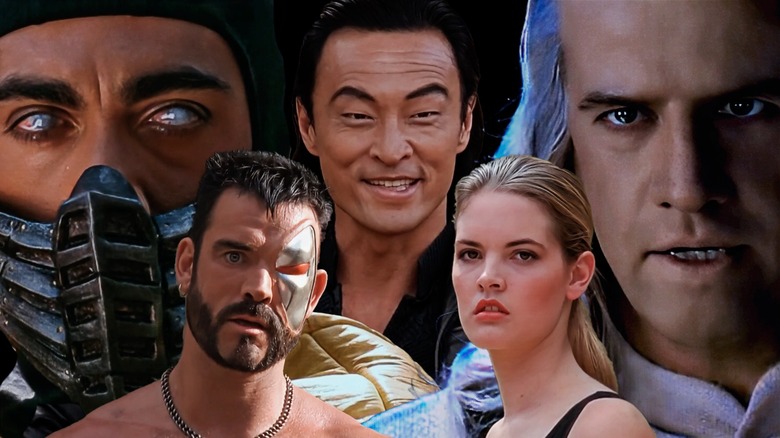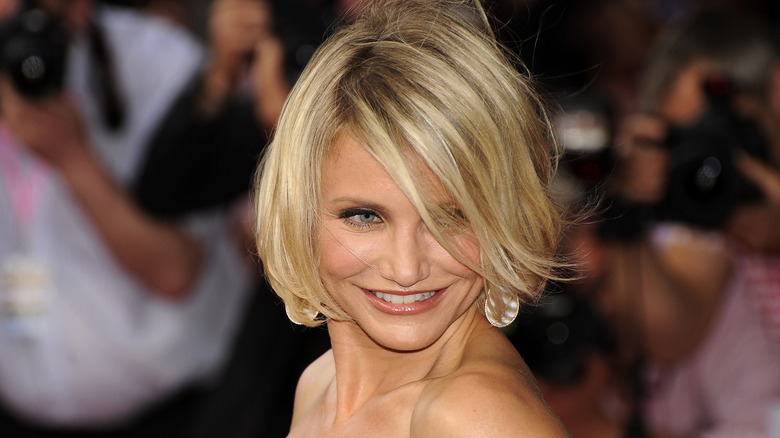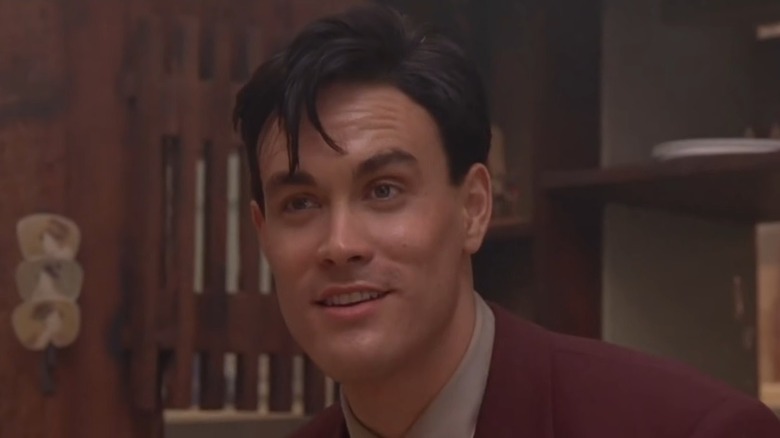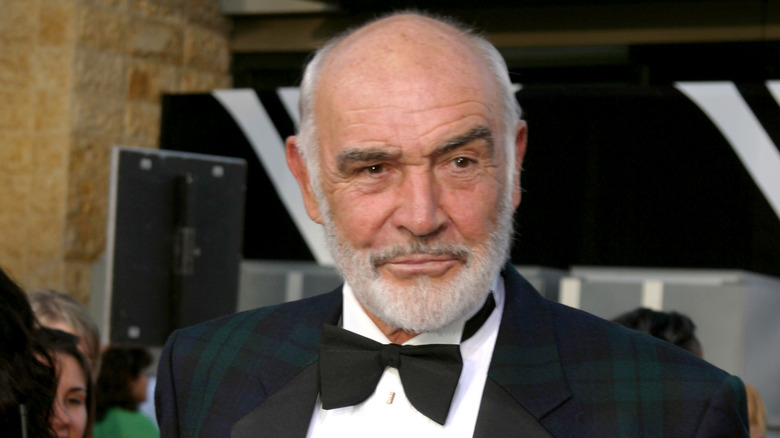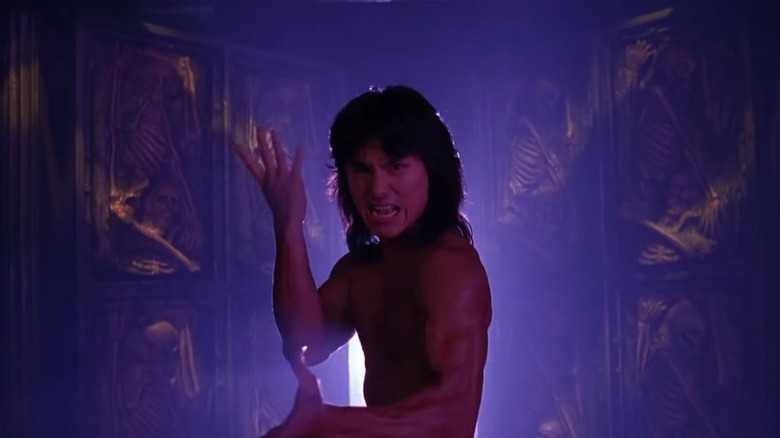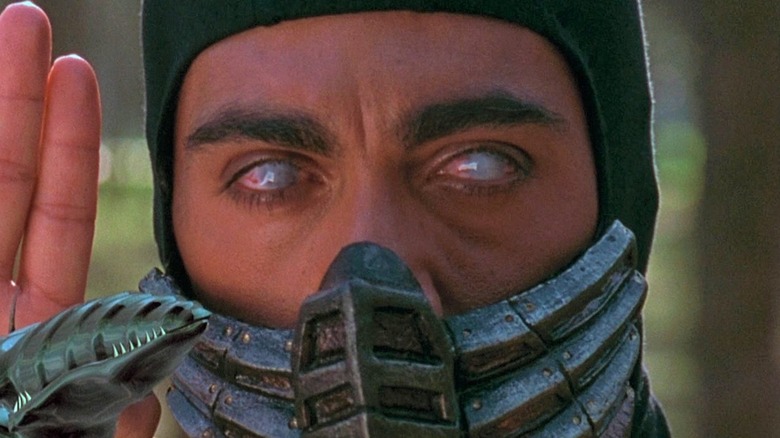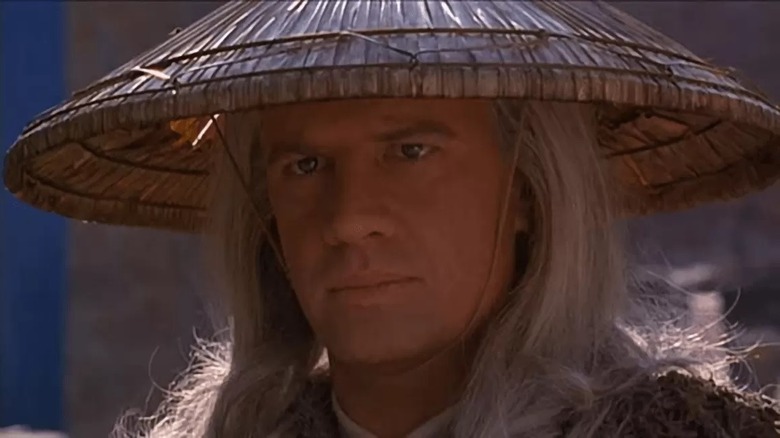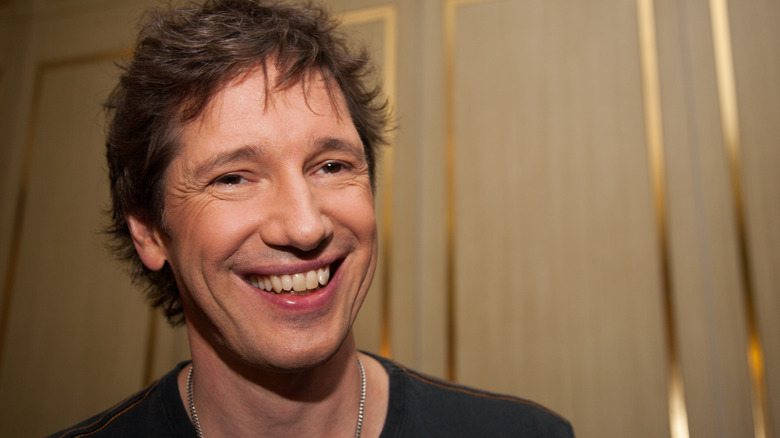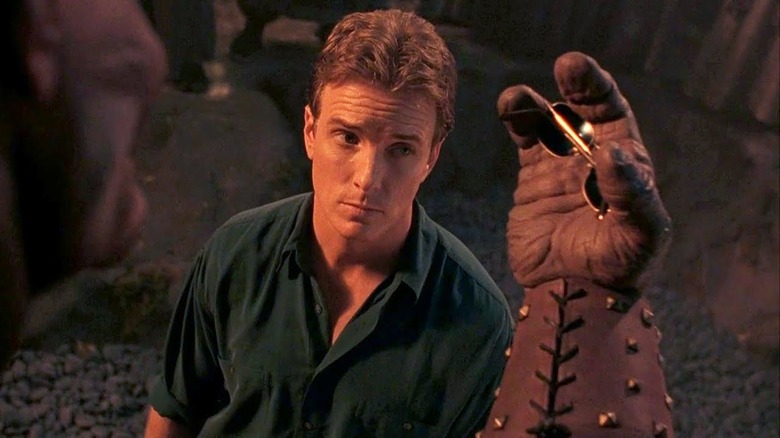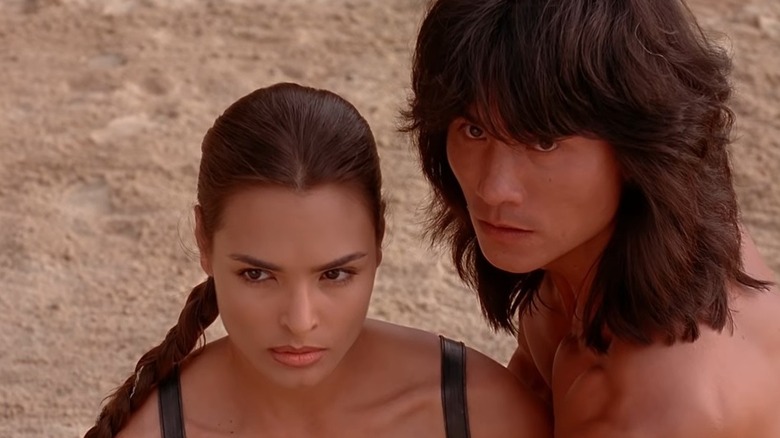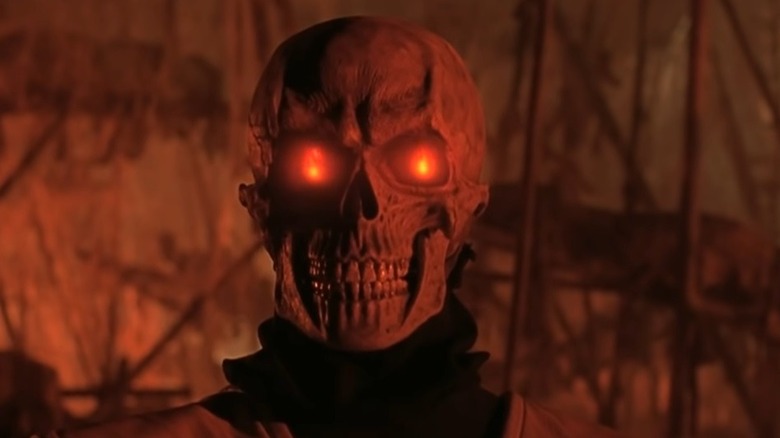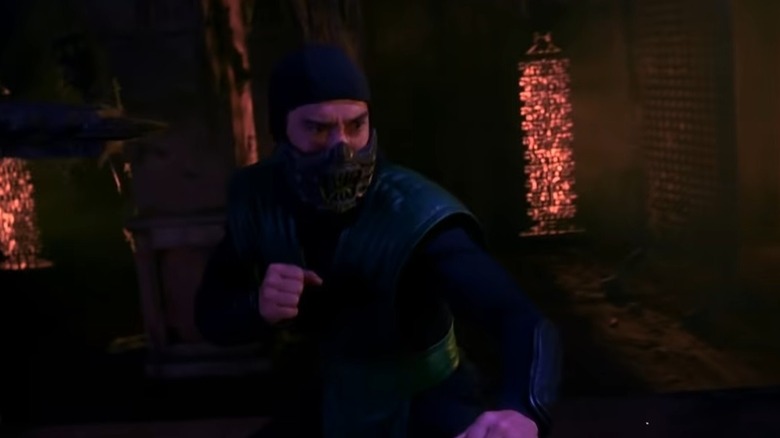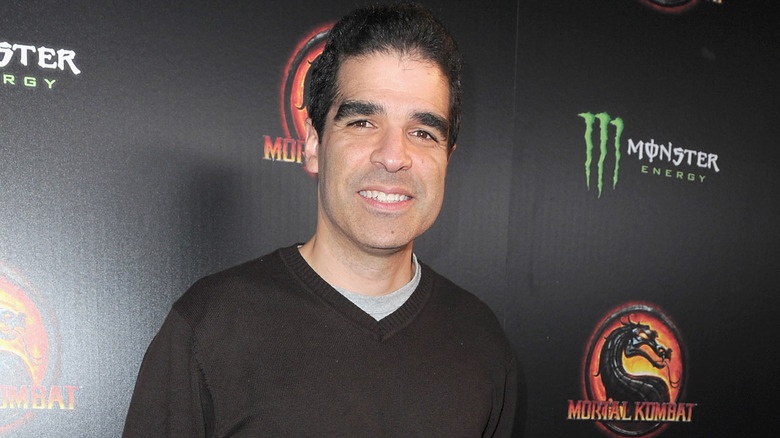Mortal Kombat: Flawless Facts About The 1995 Film
In the '90s, video game adaptations were Hollywood's Kryptonite, with these films cleaning up at the Razzies and making fans wonder why the studios even bothered in the first place. With the odds stacked against it, no one thought that 1995's "Mortal Kombat" movie would yield different results. After all, it had a relatively inexperienced director Paul W. S. Anderson at the helm, there was a lack of mainstream talent attached to the project — apart from "Highlander" actor Christopher Lambert — and it had a PG-13 rating. Considering the fatalities and general violent nature of the video game series, this felt like the ultimate cop-out.
Fans walked into the movie, expecting to have their eyes burned with something worse than anything Reptile's acid spit could do. In the end, they were roundhouse kicked by a film that captured the spirit of the game and wasn't anything close to as bad as it could've been. In fact, as the years have passed, "Mortal Kombat" has become one of the most beloved video game adaptations of all time, boasting authentic action scenes and highly quotable one-liners. Plus, the movie laughed all the way to the bank, making over $122 million at the global box office. Join us as we take a look back at the "Mortal Kombat" movie and its journey to the big screen. To quote Linden Ashby's Johnny Cage: "Let's dance!"
Cameron Diaz was originally cast as Sonya Blade
"The Mask" established Jim Carrey's status as an A-list superstar, but it also gave rise to a new name in Hollywood: Cameron Diaz. Her role as Tina Carlyle turned heads in the industry, and it's unsurprising that New Line Cinema wanted to capitalize on this and cast her in another one of its productions. "Mortal Kombat" associate producer Lauri Apelian revealed to The Hollywood Reporter that the studio invited the team to view the dailies for "The Mask" and to see more of Diaz in action. They were suitably impressed and offered her the part of Sonya Blade in the movie.
"We put her into training because she had not really done this kind of martial arts work before," Apelian said. "She broke her wrist right before shooting to the point where she couldn't do the martial arts stunts we needed."
Due to the extent of her injury, there was the need to cast another actor in the role. Bridgette Wilson-Sampras explained how she had auditioned for Sonya around seven times and believed she might not get the part after the lengthy process. However, the offer eventually came and she received a phone call asking her if she could fly out the next day to the production.
Brandon Lee was briefly considered for the role of Johnny Cage
It's no secret that Johnny Cage was largely inspired by the master of the splits and kicks, Jean-Claude Van Damme. However, it was always unlikely that Van Damme would portray the live-action version of Cage — especially after he had chosen to play Guile in 1994's "Street Fighter" movie.
For a long time, there was a rumor that Brandon Lee had been set to portray Cage until his unfortunate passing during the production of "The Crow." As the son of the legendary martial artist and actor Bruce Lee, he had the history and pedigree for the part, and he had also cemented himself as an action star in his own right in films such as "Showdown in Little Tokyo" and "Rapid Fire." Coupled with his natural charisma, Lee would have been perfect as the martial artist-turned-Hollywood actor Johnny Cage.
During a "Mortal Kombat" 20-year anniversary panel, Paul W. S. Anderson addressed the Lee as Cage rumors. "It was briefly discussed, but I don't think he was ever made an official offer or anything," Anderson said. "He was quite tight with Cary Tagawa, who is in the movie as well, so I think because of that people thought it was more of a reality than it actually was."
Sean Connery turned down the movie to play golf
In the "Mortal Kombat" franchise, Raiden is the God of Thunder and one of the most powerful characters as he leads Earth's warriors against the evil forces from Outworld. Since he's based on Raijin — the mythological Japanese thunder god — he has been portrayed as someone of Asian descent in the video games. Naturally, there was some controversy when Christopher Lambert was cast as Lord Raiden in the "Mortal Kombat" movie because he didn't look like the character at all.
That said, there was someone else who was also approached for the role of Raiden — one of Lambert's "Highlander" co-stars, Sean Connery. Speaking to The Hollywood Reporter, Lauri Apelian said, "We also inquired about Sean Connery for the Raiden role. But we understood at that time that he really wanted to golf. He wasn't interested at that time in doing a physical role."
As it turns out, Connery should have read the script before turning down the part. In the same interview with The Hollywood Reporter, Lambert explained how he was pleased to find out he didn't need to work out or get physical for the role because of how Raiden was used in the film.
Robin Shou wasn't interested in starring in Mortal Kombat at first
Undoubtedly, one of the standout stars of "Mortal Kombat" is Robin Shou, who plays the fearsome fighter Liu Kang. Despite it being his first major American film and his debut as a lead actor in a mega-blockbuster, Shou admitted he was apprehensive about taking the role of the Shaolin monk and was unconvinced about the project due to its silly name.
In an interview with SYFY Wire, Shou explained how he had steady work in the Hong Kong action scene throughout the '90s when the opportunity came knocking. "A friend of mine was a talent agent, and he said, 'You know, there's this movie called Mortal Kombat' ... First of all, it sounded stupid to me. So I said, 'No, I don't think so.' And then he kind of pressed on saying, 'Robin, this is you. You should go in.' So, I was called for another meeting, read, and so forth. And I eventually got the part."
In the end, the role of Liu Kang kickstarted the next phase of Shou's career in America, as he went on to star in films, such as "Beverly Hills Ninja," "Death Race," and "Street Fighter: The Legend of Chun-Li."
Chris Casamassa thought he was going to be a background fighter
Scorpion is one of the most treasured "Mortal Kombat" characters and has been since the first game debuted in 1992. The fiery ninja wraith's popularity demands that certain care and treatment be taken whenever he's utilized. While Scorpion isn't one of the main characters in the 1995 "Mortal Kombat" movie, he has more than enough time to shine in some exquisite action scenes.
Martial artist, stuntman, and actor Chris Casamassa played the part of Scorpion in the film. However, he had no idea he was up for the role at all. "I went through an auditioning process originally as a background fighter," Casamassa told Upcomer. "When we went to the auditions, they told us that all the roles for the film had been cast. So we went there to just become one of the background fighters because I wanted to be part of the movie because I was a big, big fan of the game at the time."
Casamassa explained how he put on a performance for his first audition, showing off his martial arts prowess and agility, and he kept getting called back for more auditions. Eventually, Paul W. S. Anderson came over and congratulated him for being chosen as Scorpion — which caught him completely off guard. Casamassa didn't ask any questions, instead choosing to be grateful he had secured such a coveted role.
Christopher Lambert was a fan of the video game before the movie
As fans, most of us expect actors to be as invested in properties and franchises as we all are. Unfortunately, the reality is not everyone will have the same level of enthusiasm or knowledge about a project. For some, it's just a job. In Christopher Lambert's case, though, he said yes to "Mortal Kombat" because he was also a fan of the video games. In a 1995 interview with GamePro magazine, Lambert revealed he was an avid gamer and had played "Mortal Kombat" before the offer for the movie came along.
"I'm a video game freak, so I knew quite a lot," he said. "What I wanted to know mostly was how the game was going to go to the big screen in live action." Lambert explained how he believed "Mortal Kombat" had a natural advantage over other video games of the time due to it possessing a rich and established storyline that could be explored. On the other hand, he threw shade at "Super Mario Bros." by questioning the depth of a story involving two heroic plumbers from Brooklyn.
There weren't too many directors interested in the movie
Despite producer Lawrence Kasanoff's belief in "Mortal Kombat" holding immense potential as a live-action film, not many other executives were convinced. Others had tried to adapt video games before and failed spectacularly, so there was little confidence that this property would be any different. Even so, one would expect that Paul W. S. Anderson had to fight off a litany of directors for the chance to direct this project. Turns out he didn't need to test his might that much.
In a retrospective chat with SYFY Wire, Anderson explained how there weren't too many directors clamoring to get behind the camera for "Mortal Kombat," due to the bad reputation of video game movies at the time. For him, he saw it as an opportunity to secure a big studio film and stick around in America, and he was also a fan of the video games. Anderson added how he had to have several meetings with New Line Cinema, where he happened to stretch the truth about his knowledge and aptitude for visual effects. The tactical gambit worked in the end and he was hired.
The director was bummed out by the initial critical reception
Paul W. S. Anderson, the cast, and the crew pushed the boulder up the hill and got "Mortal Kombat" made and in theaters by August 1995. However, the film wasn't exactly embraced by the critics, and it received a slew of bad reviews — with some being particularly brutal — and the movie sits with a 45% critical approval rating on Rotten Tomatoes.
Despite the less-than-flawless reception, "Mortal Kombat" uppercut its way to the top of the box office, ruling for three weeks and becoming a worldwide smash-hit in the process. For Anderson, though, the critical reception cut deeper than Baraka's blades at first. "The day after [opening], all I could remember was the negative stuff," Anderson told Entertainment Weekly.
However, he had to go through this to change his perception of what defines filmmaking success. He explained how it made him realize that the audience is all that matters to him — not the critical reviews.
A romance was cut from the final film
The premise for the "Mortal Kombat" movie is simple: Raiden chooses Liu Kang, Sonya Blade, and Johnny Cage to be Earth's defenders in a tournament against Shao Kahn's Outworld. Outworld has won nine of these tournaments in a row, and it cannot win the tenth or else Shao Kahn will be able to conquer Earth. Of course, there's a twist of treachery from Shang Tsung and a few more action-centric subplots, but it's an easy story to follow.
One thing that is missing from "Mortal Kombat," though, is romance. While it's hinted at between Cage and Blade — and with Kang and Princess Kitana — matters of the heart make way for a greater focus on action and fights. According to an interview Robin Shou did with Goldsea, this wasn't always the case.
"In the original script I was supposed to fall in love with Talisa [Soto's Kitana]," he said. "I was looking forward to it, but they thought we have so much action, we don't want to add romance to it. They cut it out." That said, Liu Kang and Princess Kitana revive their feelings for each other in the sequel, "Mortal Kombat: Annihilation."
The two biggest fight scenes were added after principal photography wrapped
Some viewers might not realize that a production that goes in front of the camera for the first time isn't the final movie they see on screen. After "Mortal Kombat" wrapped principal photography and aired a rough cut to a test audience, the consensus was unanimous: it needed more fighting. So the team went back for reshoots to film two more fight scenes: the Johnny Cage and Scorpion battle on the scaffolding and Liu Kang versus Reptile in Outworld.
Speaking to Kung-fu Kingdom, Keith Cooke — who portrayed Sub-Zero and Reptile in the film — said, "They built sets and Robin [Shou] called me basically saying he needed somebody to come in and have a really great fight — Robin wanted to fight me! They built a set in an airplane hangar at Van Nuys airport for that and the Scorpion fight done with Chris Casamassa." Cooke added how he believed they were two of the more intricate fight scenes in the film — and the audience agreed with him, as most fans see those as the two most iconic battles from "Mortal Kombat."
The actors suffered major injuries for the fight scenes
Regardless of what anyone thinks of the quality of the "Mortal Kombat" movie, there's something no one can dispute: the action is top-notch. The fluidity of the action scenes means that there isn't the opportunity to insert cuts to transition between the actors and stunt performers. As a result, the actors had to train and learn how to do the fighting themselves.
Linden Ashby said to The Hollywood Reporter that his co-star Chris Casamassa was also responsible for his fight training. However, there was an incident during one of their scenes together as Johnny Cage and Scorpion. Ashby explained how the scene called for Scorpion to drop a kick on Cage's kidneys, so he had padding there to protect himself. Unfortunately, Casamassa's heel managed to hit an exposed spot, causing a painful and bruised kidney for Ashby.
In the same interview with The Hollywood Reporter, Shou revealed how Liu Kang's scuffle with Reptile resulted in him breaking his ribs. "In one of the stunts, Reptile threw me and I hit this pillar and I actually fractured two ribs on that, because I didn't expect I'd hit the edge of the pillar," he said, adding he didn't tell anyone because he feared they would stop filming. Shou took Advil and told his co-star Keith Cooke to not target that specific side of his body during the rest of the shoot, then he went to the hospital after they were done.
The movie made Ed Boon realize how big Mortal Kombat really was
By the time "Mortal Kombat" arrived in theaters, the video game series was on its third entry and going from strength to strength. The franchise had established itself as one of the premier fighting games alongside "Street Fighter," while also annihilating the Capcom franchise in numerous territories. Teenagers around the world were screaming "get over here" to all their friends as Sub-Zero and Scorpion became household names at this point in history. Yet, "Mortal Kombat" co-creator Ed Boon didn't realize how colossal this franchise was becoming until the movie came out.
In a wide-spanning interview with Game Informer, Boon explained how the development cycle of the series prevented him from fully realizing the impact of the franchise until 1995. He and his colleagues would start work on the next installment of the video game as soon as the previous one was released, so they never got a chance to sit back and watch the success unfold in the early years. It was only when the film made a seismic splash that Boon understood the influence "Mortal Kombat" had on the world.
